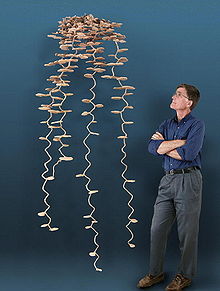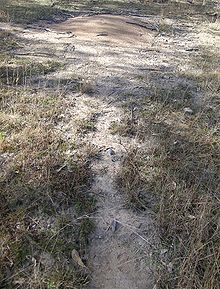- Ant colony
-
An ant colony is an underground lair where ants live, eat and mate. Colonies consist of a series of underground chambers, connected to each other and the surface of the earth by small tunnels. There are rooms for nurseries, food storage, and mating. The colony is built and maintained by legions of worker ants, who carry tiny bits of dirt in their mandibles and deposit them near the exit of the colony, forming an ant-hill. Food carried in by workers is retrieved from the surrounding environment and can be traced from colony to colony by the use of isotopes.[1]
Ant colonies are eusocial, and are very much like those found in other social Hymenoptera, though the various groups of these developed sociality independently through convergent evolution. Eggs are laid by one or sometimes more queens. Queens are different in structure; they are the largest ants of the colony as a consequence of their egg-laying. Most of the eggs that are laid by the queens grow up to become wingless, sterile females called "workers". Periodically, swarms of new winged queens and males (the alates) are produced in most species, which leave to mate. The males die shortly thereafter, while the surviving queens either found new colonies or occasionally return to their old one. The surviving queens can live up to around 21 years. People raise ant colonies in captivity for research and as a hobby. An "ant terrarium" used for this purpose is called a formicarium. They are often made thin enough that one can see the entire colony inside their nest. These are also called ant farms.
Contents
Unicoloniality and supercolonies
Most commonly, ants from different nests exhibit aggression toward each other. However, some ants exhibit the phenomenon called unicoloniality, where worker ants freely mix between different nests. A group of nests where ants do not exhibit mutual aggression is known as a supercolony — this form of organization is known as supercoloniality, and ants from different supercolonies of the same species do exhibit mutual aggression. Populations in supercolonies do not necessarily span a contiguous area.[2]
Until 2000, the largest known ant supercolony was on the Ishikari coast of Hokkaidō, Japan. The colony was estimated to contain 306 million worker ants and one million queen ants living in 45,000 nests interconnected by underground passages over an area of 2.7 km2 (670 acres).[3] In 2000, an enormous supercolony of Argentine ants was found in Southern Europe (report published in 2002). Of 33 ant populations nested along the 6,004-kilometre (3,731 mi) stretch along the Mediterranean and Atlantic coasts in Southern Europe, 30 belonged to one supercolony with estimated millions of nests and billions of workers, interspersed with three populations of another supercolony.[2] The researchers claim that this case of unicoloniality cannot be explained by loss of their genetic diversity due to the genetic bottleneck of the imported ants. In 2009, it was demonstrated that the largest Japanese, Californian and European Argentine ant supercolonies were in fact part of a single global "megacolony".[4]
Another supercolony, measuring approximately 100 km (62 mi) wide, was found beneath Melbourne, Australia in 2004.[5]
Ant-hills
A giant ant hill in Zambia.
An ant-hill, in its simplest form, is a pile of earth, sand, pine needles, or clay or a composite of these and other materials that build up at the entrances of the subterranean dwellings of ant colonies as they are excavated. A colony is built and maintained by legions of worker ants, who carry tiny bits of dirt and pebbles in their mandibles and deposit them near the exit of the colony. They normally deposit the dirt or vegetation at the top of the hill to prevent it from sliding back into the colony, but in some species they actively sculpt the materials into specific shapes, and may create nest chambers within the mound.
In some areas of the world including English-speaking countries of Africa, in common speech the term ant-hill (also written as "anthill") refers to a termite mound. Note that termites are not ants
Giant ant hills like the one on the right found in Zambia are often used to make clay bricks as the clay in the anthills is above the surface which saves time digging large holes in the ground to get to it. They are built by termites which are photosensitive so it is safe to dig into their hills without their attacking anyone
See also
- Nuno sa punso, a Filipino belief about ant hills.
- Ant colony optimization, a technique in computer science inspired by ant colonies
References
- ^ Blüthgen, Nico; Gerhard Gebauer, Konrad Fiedler (2003-11-01). "Disentangling a rainforest food web using stable isotopes: dietary diversity in a species-rich ant community". Oecologia 137 (3): 426–435. doi:10.1007/s00442-003-1347-8. PMID 12898386.
- ^ a b Tatiana Giraud, Jes S. Pedersen, and Laurent Kelle. Evolution of supercolonies: The Argentine ants of southern Europe. The National Academy of Sciences, 2002.
- ^ Higashi, S. and K. Yamauchi. Influence of a Supercolonial Ant Formica (Formica) yessensis Forel on the Distribution of Other Ants in Ishikari Coast. Japanese Journal of Ecology, No. 29, 257-264, 1997.
- ^ Ant mega-colony takes over world BBC Wednesday, 1 July 2009 10:41 GMT.
- ^ Super ant colony hits Australia. BBC News, 2004.
External links
Categories:- Myrmecology
- Superorganisms
- Insect ecology
- Shelters built or used by animals
Wikimedia Foundation. 2010.




